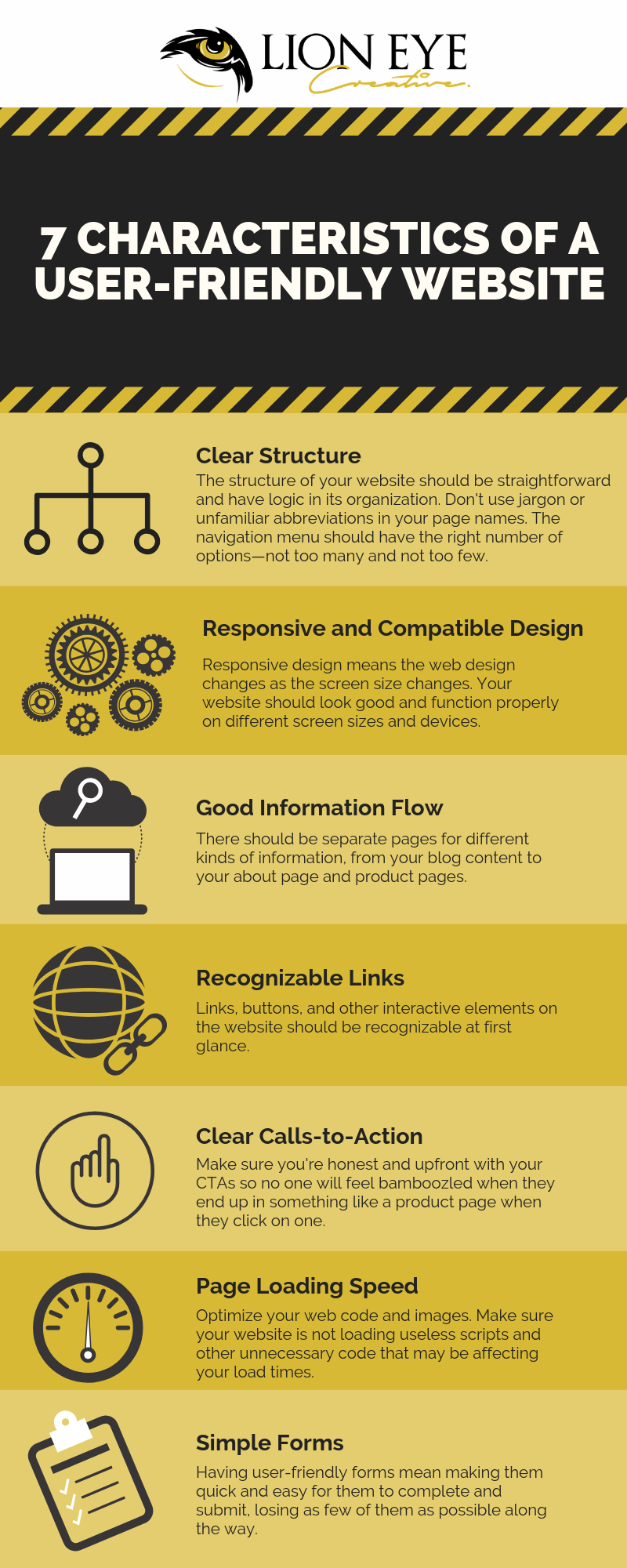7 characteristics of a user-friendly website

Few things in this world are worse than a website that you can’t find what you’re looking for in. The website is the most important tool a business has for giving information about its products and services. Therefore, it’s crucial for a website to be designed for delivering content and information to users.
Many things go into the usability and accessibility of a website. Here are the 8 main characteristics a website must have to be user-friendly.
Clear Structure
Visitors should be able to go to any page on your website and quickly know what they’re looking at. It should be easy for them to navigate to the rest of your website from anywhere without having to guess and backtrack.
The structure of your website should be straightforward and have logic in its organization. Don’t use jargon or unfamiliar abbreviations in your page names. The navigation menu should have the right number of options—not too many and not too few.
Finally, make sure there are no broken links that may lead them to 404 error pages and dead ends that don’t have other helpful links to lead them to other content in your website.
Responsive and Compatible Design
Your website should look good and function properly on different screen sizes and devices. It should also be viewable on all the popular web browsers. With the myriad of ways people browse the web these days, your website should accommodate for all of them.
That’s why your website must be optimized with responsive design and be tested in all the modern web browsers in all desktop and mobile platforms. While this may seem like a lot of work, it’s worth the trouble as usability is of utmost priority when it comes to a business website.
Responsive design means the web design changes as the screen size changes. It can respond to whatever and however it’s being viewed, and that’s only possible if it’s designed accordingly and is compatible with every possible web browser it may be viewed in.
Good Information Flow
Your content is reliant on your website’s information flow. It’s all about how things are laid out on your website, dictating whether it’s easy for users to scan and see what they’re looking for. That all boils down to consistent web design in every single page on your website.
There should be separate pages for different kinds of information, from your blog content to your about page and product pages. Each different purpose must be made distinct while still having the overall look and feel of the website be the same.
This can be achieved with proper use of headings, paragraph breaks, images, and so on. Make good use of white space to separate different forms of information on each page. It’s all about hitting the right balance between aesthetics and information.
Recognizable Links
The rule of thumb here is if it’s intended to be clicked on, then it should definitely look like it can be clicked on. Links, buttons, and other interactive elements on the website should be recognizable at first glance.
Text links (with anchor text) should be in a color that make them stand out. The anchor text must be descriptive of what it’s linking to and not just say something like “click here” since that’s not very SEO friendly. They should also be underscored to make them more distinguishable.
Buttons should look like buttons without being too tacky. It’s not to say they must look completely 3D, but they should look like they’re buttons to be clicked on. That’s where your calls-to-action usually go, so make sure they look like CTA buttons.
You may also take the extra mile and make links that are going to send users to a website outside of yours to look different as well, as long as it won’t clash with the rest of your web design.
Clear Calls-to-Action
A big part of why a business would have a website is to get more conversions. You can do that with calls-to-action (CTAs), and having clear CTAs will make your posts yield more conversions.
CTAs are all about setting clear expectations, letting users know exactly what will happen if they click on one. Make sure you’re honest and upfront with your CTAs so no one will feel bamboozled when they end up in something like a product page when they click on one.
Page Loading Speed
Nothing is more discouraging to a user than a web page that takes way too long to load. Having to wait for more than a few second for a page to load can have them looking elsewhere for whatever they’re looking for. That’s why your page loading speed should be as fast as possible.
There are a few steps you must follow to ensure good page loading speed. First is to optimize your web code and images. Make sure your website is not loading useless scripts and other unnecessary code that may be affecting your load times.
You’ll also want to make sure that every image your website loads is compressed and optimized. While it’s good to have images in good quality, you have to find a balance between that quality and file compression so they’re as small as they can be.
Also make sure that you only load images and other non-text elements only when you have to. The smaller and fewer they are, the quicker they’ll load.
Simple Forms
Forms are important for business websites as they collect information from users for things like email newsletters, membership registrations, and payments.
Having user-friendly forms mean making them quick and easy for them to complete and submit, losing as few of them as possible along the way.
Make sure your forms don’t ask for information that’s not needed, or at least not have required fields that aren’t that important to begin with. The fields must flow in a logically sequential manner with similar ones grouped together and categories spaced out properly.
It’s also a plus to have fields be navigable by keyboard so that users who know how to use the keyboard to switch between fields can do so easily. It adds to the form’s overall usability.
Finally, make sure to have a confirmation message upon submission to let users know their information was properly submitted. This ensures that there are less duplicate entries to deal with.
7 Characteristics of a User-Friendly Website [Infographic]

